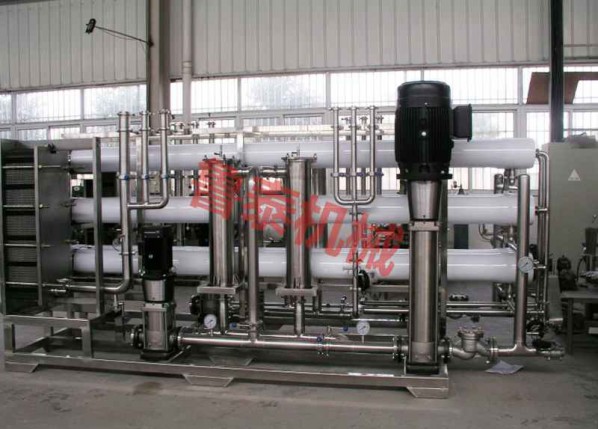Product description
Nanofiltration equipment (NF)
Nanofiltration membrane (NF) the main removal diameter of 1 nanometer (nm) solute particles around the cut-off molecular weight is 100 ~ 1000, a big feature of nanofiltration membrane body is charged, this is it at a very low pressure still has high desalination performance and MWCO of hundreds of film. Can also be an important reason of removal of inorganic salt.
Without any chemical reaction of nanofiltration membrane separation process, without heating, no phase change, does not destroy the biological activity, will not change the flavor, aroma, and a variety of separation and concentration of more and more widely used in drinking water and preparation of food, medicine, biological engineering, pollution control and other industries in the purification process.
Detailed introduction
NF operating principle
Membrane separation is the different effect on the permeation properties of each component in the mixture by membrane, gas force for binary or multi-component mixture or liquid separation, classification, purification and enrichment methods by external energy or chemical potential for. The membrane diameter is nanometer, suitable for separation of molecular weight in 100~1000, and molecular size of about 1 nm dissolution component of membrane process is called nanofiltration (NF). The transmembrane pressure required for NF membrane separation is typically 0.5 to 2 MPa, and the pressure difference required to achieve the same osmotic energy as the reverse osmosis membrane is 0.5 to 3 MPa lower. Depending on the operating pressure and the separation limit, the NF can be qualitatively placed between reverse osmosis and ultrafiltration, sometimes referred to as "low-pressure reverse osmosis" or "porous reverse osmosis" (NF)". In 1970s, J. E. Cadotte studied the NS-300 film, which was the beginning of the study of NF film. At that time, Israel desalination company used "mixed filtration" to represent the membrane separation process between reverse osmosis and ultrafiltration. Later, the American company called this membrane technology nanofiltration, and has been using it until now. After that, NF developed very rapidly, and membrane components were commercialized in the mid 80s. At present, NF has become one of the hotspots in the field of membrane separation in the world.
Characteristics of AS-NF nanofiltration equipment
1, the core membrane components adopt imported organic membrane, membrane technology combined with the technical requirements and the specific needs of users of different types, different components to ensure system performance, endometrial interception of membrane flux and membrane set the stability and reliability of the system.
2. Nanofiltration system can realize the desalination and concentration of materials at low operating pressure, and the production cycle is short, desalination is more complete, and the product has high purity and good quality stability.
3, according to the specific needs of customers, the nanofiltration membrane can be passed through the liquid recycling, and membrane components through professional cleaning, can be restored to the membrane components of the * * * good performance, and fully realize the economic efficiency of membrane equipment.
4, the process is always in the normal state, and no phase, the material of each effective component without any adverse effects, especially suitable for treating the heat sensitive material, the product has a high content of effective components, according to the requirements of technology can continue to enter the next section or the direct drying process.
5 ŃĆü the system adopts full closed pipe type operation, safe and hygienic work site, can meet the requirements of GMP or FDA standardized production.
6, because the system has no phase change, it is always in the normal temperature condition, so the energy consumption is low and the operation cost is low.
7, the integration of technology is high, the layout is reasonable, fully automatic control, on-line monitoring of important process parameters, at any time to grasp the system operation.
Technological process description of NF water treatment equipment
1, raw water tank (optional)
Storage of raw water for settling large sediment particles and other precipitating substances in water. Meanwhile, the water pressure in the original pipe is buffered and the impact on the water treatment system is also buffered. A pressure sensitive response (as caused by low or excessive hydraulic pressure).
2 raw water pump
Constant system water supply pressure, stability of water supply, to ensure that the raw water through the front sand filter, carbon filter, softening tank, there is enough water and water pressure, to provide high-pressure pump work.
3. Quartz sand filter
Using multiple filtering layer filter, the main purpose is to remove the substances in raw water and sediment, rust, colloid, suspended particles in the 20um above, can reverse flushing, flushing is a series of operations using manual valve control or automatic controller. Ensure the water quality of the equipment and prolong the service life of the equipment.
4, activated carbon filter
The system uses the shell or coconut shell activated carbon filter, activated carbon can not only adsorb electrolyte ions, but also do ion exchange adsorption. The adsorption of activated carbon can also make Potassium Permanganate oxygen consumption (COD) by 15mg/L (O2) to 2 ~ 7mg/L (O2), in addition, due to the surface by adsorption increased concentration of copying, has also played three halide catalysis, removal of pigment, odor, chlorine, reducing water biochemical organic matter the value of pesticides and pollutants and remove water and other pollutants (THM). Can choose manual valve control or automatic controller for backwashing, washing and a series of operations. Ensure the water quality of the equipment and prolong the service life of the equipment. At the same time, the equipment has the self maintenance system, the operating cost is very low.
5 ion softening system / dosing system (optional)
In order to prevent the concentrated water end especially after a nanofiltration device * * * membrane concentrated water side CaCO3, MgCO3, MgSO4, CaSO4, BaSO4, SrSO4, SiSO4 concentration is greater than the equilibrium solubility product constant of crystallization, the characteristics of the damage of the original film, before entering the membrane module, use ion softener or scale put the amount of agent to prevent SiO2, carbonate, sulfate crystal precipitation.
6, precision (safety) filter
The precision filter of suspended matter in water and non residual particles and colloid removal, the following equipment operation etc. nanofiltration system safer and more reliable. The filter core is 5um filter core. The purpose is to prevent the impurities in the upper filter unit from being removed by more than 5um. Prevent the reverse osmosis device from damaging the surface of the membrane, thereby damaging the desalination performance of the membrane.
7 ŃĆü high pressure pump
Vertical multistage stainless steel centrifugal high pressure pump, which is an important component of nanofiltration host, is used to transport a certain amount of water to the nanofiltration membrane. Its quality is very important to the whole machine. The use should be guaranteed not to idle, not long-term overload operation, often required to exclude air, should ensure the drying of electrical components.
8 nanofiltration system
NF hosts using the pump pressure so that the solution of the solvent separated by nanofiltration membrane, the removal of harmful substances in water, organic matter, bacteria will be most colloid and high molecular weight removal, while retaining some trace elements.
9 ozone and ultraviolet sterilizer
Ozone is used to kill bacteria and viruses in the water, so as to prevent the water tank from producing new bacteria, and completely guarantee the water quality of the pure water.
10, finished tank
Storage of sterilized finished water, supply water points, and ensure adequate water supply. At the same time to prevent the two pollution, pipes and other stagnant water cause bacteria breeding, circulating pumps continue to transport, ozone mixing, sterilization, to ensure fresh water quality.
11, booster pump
Ensure the water supply and pressure of the water supply point.
Applicable scope of nanofiltration equipment
1, softening water: remove Ca, Mg and other hardness components.
2 drinking water: the traditional drinking water treatment mainly through flocculation, sedimentation, sand filtration and chlorination disinfection come and go in addition to the suspension of water and bacteria, and the removal of various dissolved chemicals is very low. With the increasing pollution of water sources and the improvement of drinking standards in various countries, more attention has been paid to the advanced treatment of drinking water, which can remove various organic substances and harmful chemicals.
The operation practice shows that a large number of industrial equipment, nanofiltration membrane can be used for three halomethane intermediates containing THM removal in surface water and ground water (the byproduct of chlorination for carcinogens), low molecular organic compounds, pesticides, odor substances, nitrate, sulfate, fluorine, boron, arsenic and other harmful substances.
3 ŃĆü food, beverage and pharmaceutical industry: the application of nanofiltration membrane in this field is very active, such as the concentration and refinement of various proteins, amino acids, vitamins, milk, liquor, spices and so on.
4. Chemical industry: concentration and separation.
5. Treatment of reclaimed water and wastewater:
(a) treatment of wastewater from daily chemical industry. The application of NF membrane in daily chemical wastewater treatment shows that NF membrane has good acid retention resistance, good retention rate, good removal rate of heavy metals and no membrane pollution. It is estimated that the operating cost of NF membrane is lower than reverse osmosis technology, and the removal rate of organic small molecules can be more than 90% of the daily chemical wastewater treatment.
(b) wastewater treatment in the petroleum industry. The wastewater of petroleum industry mainly consists of waste water containing various inorganic salts and organic compounds in the process of petroleum extraction and refining. The composition of the wastewater is very complicated and difficult to handle. Membrane method, especially NF method, can be used to treat wastewater effectively and recover useful substances. For example, the crude oil wastewater is separated into aqueous rich oil and non oil water phase with NF membrane, then the oil rich phase is added into the washing process and fresh water, such as recycling and saving water in crude oil. In the past, the methods of reverse osmosis and phase separation were used to treat the wastewater from petroleum industry. However, there are serious problems of membrane fouling. If a NF film is added before reverse osmosis, the problem of membrane fouling can be solved. Phenol waste water containing oil industry mainly containing phenol, methyl phenol, nitrophenol and various substituted phenols, such substances are toxic, must be removed before discharge, if using NF technology, not only the removal of phenol can reach above 95%, and under lower pressure can efficiently, nickel and cadmium in wastewater mercury and other heavy metals of high titanium ion removal, the cost is much lower for reverse osmosis.
(c) treatment of pesticide wastewater. The general water treatment method can not remove the low molecular organic pesticides in polluted water. Through the study of NF films on the retention properties of non phenolic pesticides, found that in addition to two other pesticides except chloride, retention rates were higher than 96.7%, the adsorption capacity of all pesticides on NF film are influenced by the hydrophobic. NF treatment of wastewater containing phenolic insecticides is also very effective.
(d) waste water treatment of chemical fiber printing and dyeing industry. Used for the removal and reuse of dyes and auxiliaries in the drainage of printing and dyeing process. The treatment of dye slurry polymerization, the molecular weight of dyes in the majority of hundreds to thousands, NF film can make some inorganic salts or small molecules to pass through, and the interception of dye molecules is large, the crude dye slurry by NF system after the dye can be enriched, and the concentration of the inorganic salt drop, desalination rate is greater than 98%, dye the loss rate of less than 0.1%, and can run under high temperature. In addition, NF can also be used for the treatment, recovery and reuse of oily wastewater in fiber processing.
(f) treatment and recovery of two wastewater from thermal power plant. The two wastewater mainly from thermal power plant ash and dust removal and cooling system, containing suspended solids, large amounts of ash and high content of salt and organic matter in the wastewater. NF can be used to treat this kind of wastewater into industrial water reuse. First remove the water by microfiltration all suspended particles, total mass fraction of 99% BOD, 98% COD, 73% of the total nitrogen and 17% of the total number of colonies, while the water is reduced to 3 ~ 4 /L, and then adding acid to reduce the PH to remove CO2, * * * after NF desalination, boiler water quality reached the.
(g) treatment of pickling waste liquid. The pickling process in the steel mill involves pickling the steel into a sulfuric acid bath with a mass fraction of about 20%. With acid, sulfuric acid concentration decreased, ferrous sulfate concentration increased, when the concentration of ferrous sulfate solution and sulfuric acid to 6% ~ 8%, generating more than 200 ~ 250g/L, pickling rate, replacement of acid solution must discharge pickling waste liquor. The acid treated steel must be washed with clean water to remove the acid from the surface and cause the waste water to be drained out. In order to protect environment and save resources, NF process can be used to treat acid washing liquid. The sulfate and ferrous sulfate, the retention rate of different use of NF membrane, the ferrous sulfate entrapped in the concentrated liquid, and then the concentrated liquid into the cooling crystallization tank, cooling crystallization of FeSO4? 7H2O; through the liquid after another can NF membrane interception of sulfuric acid, after the interception of 20% sulfuric acid concentration, acid regeneration through recycling, solution is discharged to waste water discharge or recycling station, further processing. This process recycles sulfuric acid and ferrous sulfate, and realizes the recovery, comprehensive utilization of acid washing liquid and the discharge of waste acid water to standard.
(H) papermaking wastewater treatment. NF membrane technology can be used to remove dark lignin more effectively than traditional chemical treatment. The lignin produced during the bleaching of wood pulp is negatively charged and is easily entrapped by negatively charged NF membranes and does not cause contamination of the membrane. In addition, reverse osmosis technology is not necessary because the removal rate of cationic (Na+) is not strictly required during the whole process. Ultrafiltration / nanofiltration has a good effect on the treatment of wastewater from kraft paper production.





